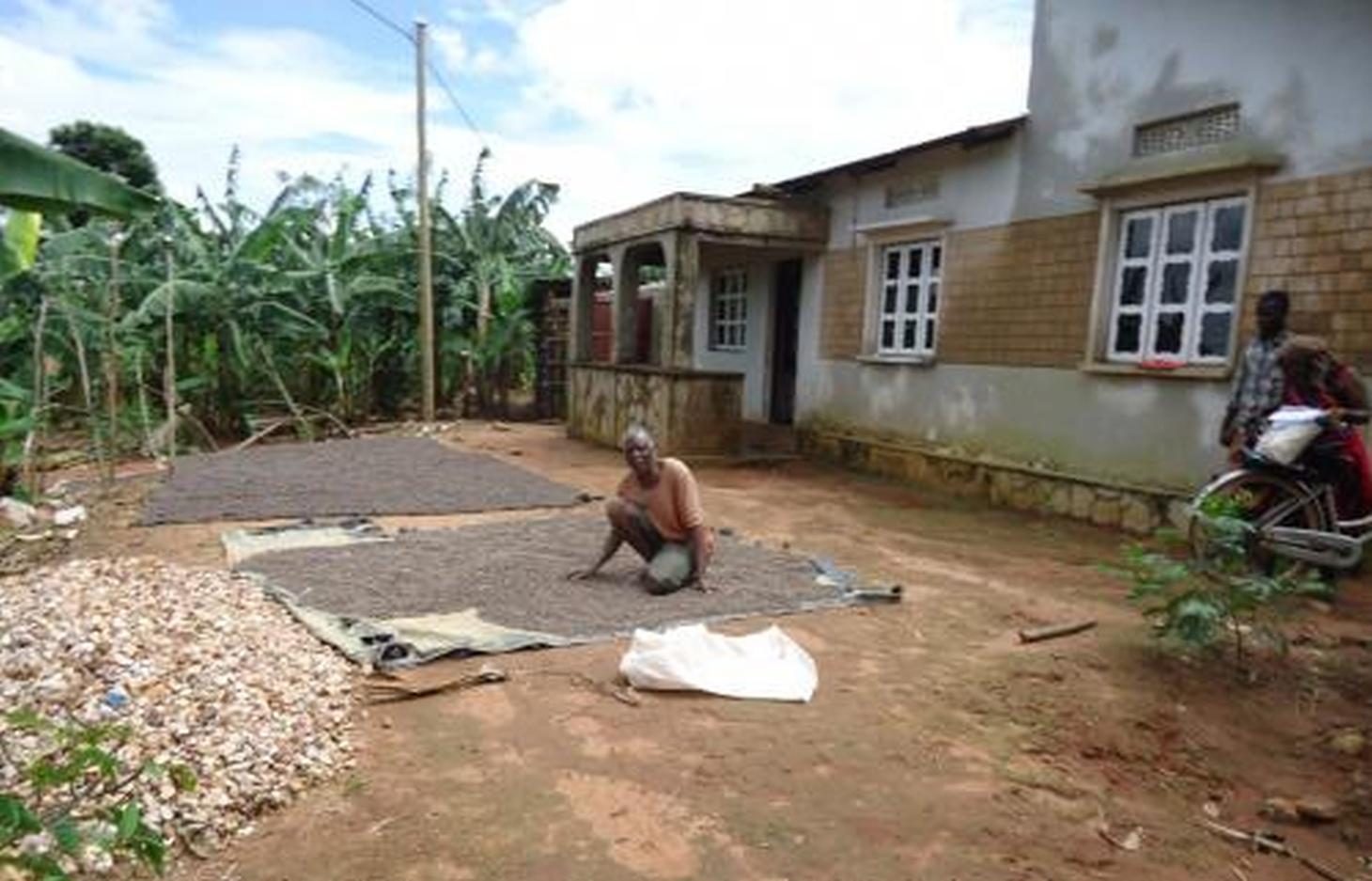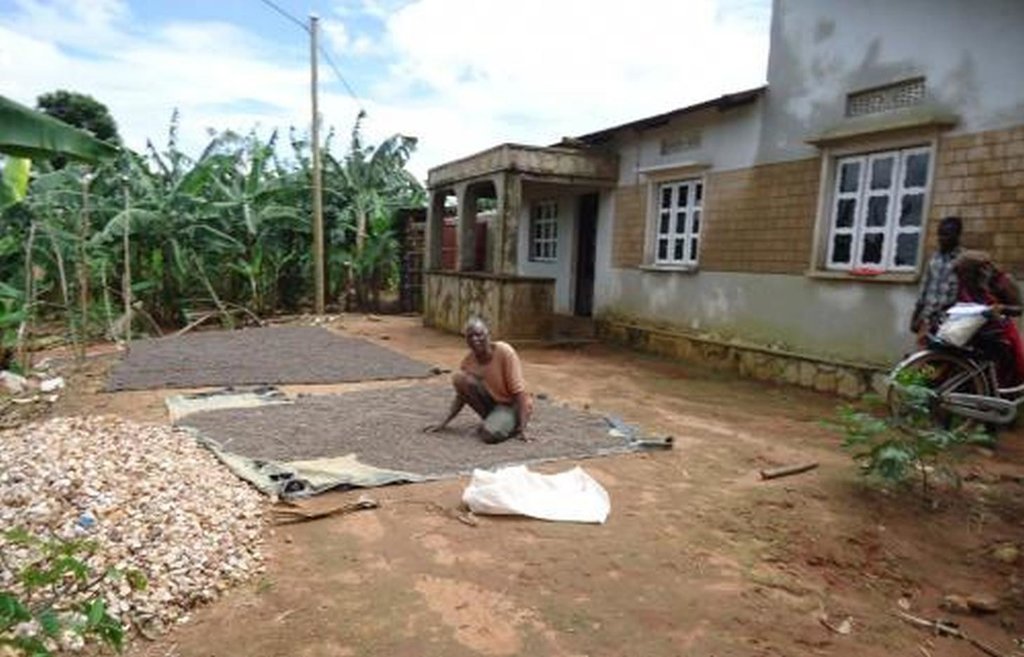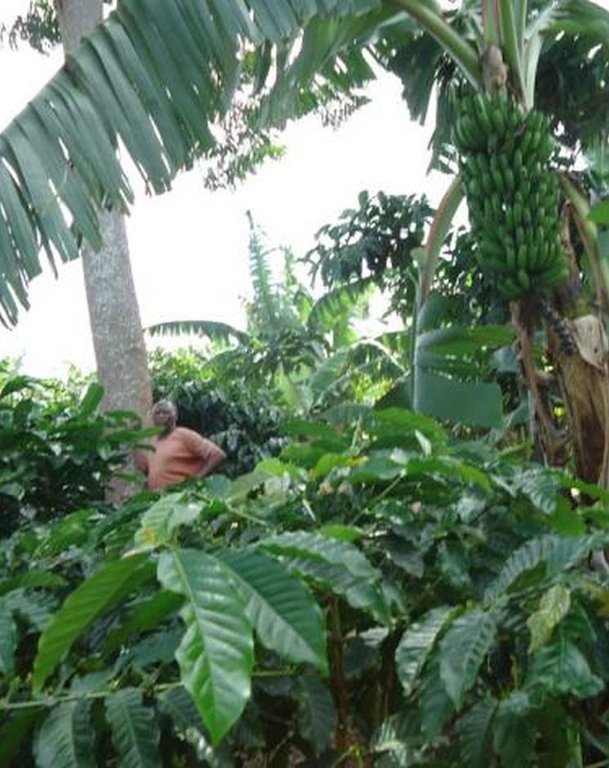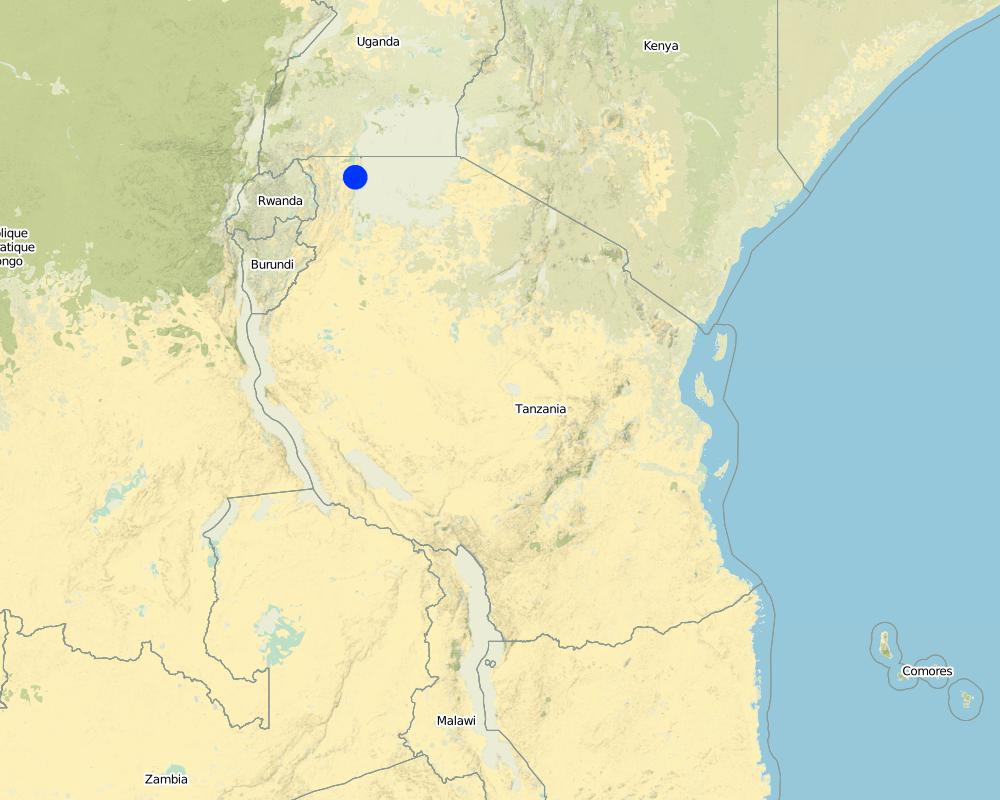Buhaya agroforestry system [Tanzanie]
- Création :
- Mise à jour :
- Compilateur : Godfrey Baraba
- Rédacteur : –
- Examinateurs : David Streiff, Alexandra Gavilano
Ekibanja (Kihaya)
technologies_1177 - Tanzanie
Voir les sections
Développer tout Réduire tout1. Informations générales
1.2 Coordonnées des personnes-ressources et des institutions impliquées dans l'évaluation et la documentation de la Technologie
Spécialiste GDT:
Government :
Government :
Mashauri Babylus
Bukoba DC
Tanzanie
Government :
Rutatatinisibwa Dominick
Bukoba DC
Tanzanie
Government :
Rwezaula Raphael
Bukoba DC
Tanzanie
Spécialiste GDT:
Kaihura Fidelis
K-TAMP
Tanzanie
exploitant des terres:
Shaaban Habibu
Kyema village farmer
Tanzanie
Nom du projet qui a facilité la documentation/ l'évaluation de la Technologie (si pertinent)
The Transboundary Agro-ecosystem Management Project for the Kagera River Basin (GEF-FAO / Kagera TAMP )Nom du ou des institutions qui ont facilité la documentation/ l'évaluation de la Technologie (si pertinent)
Food and Agriculture Organization of the United Nations (FAO) - ItalieNom du ou des institutions qui ont facilité la documentation/ l'évaluation de la Technologie (si pertinent)
Bukoba district council (Bukoba district council) - Tanzanie1.3 Conditions relatives à l'utilisation par WOCAT des données documentées
Le compilateur et la(les) personne(s) ressource(s) acceptent les conditions relatives à l'utilisation par WOCAT des données documentées:
Oui
1.5 Référence au(x) Questionnaires sur les Approches de GDT (documentées au moyen de WOCAT)
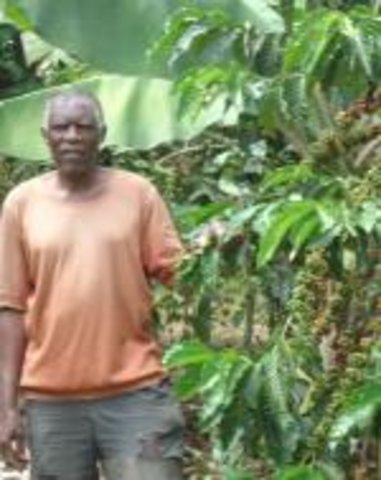
Indigenous knowledge transfer [Tanzanie]
Indigenous knowledge transfer, is a common phenomena in farming societies whereby elders taught younger generations the practical aspects in production and emphasizes the norms and proms in folk story tales.
- Compilateur : Godfrey Baraba
2. Description de la Technologie de GDT
2.1 Courte description de la Technologie
Définition de la Technologie:
Traditional agroforestry system comprising mixture of banana, coffee, fruit trees, biannual crops, annual crops and timber trees which together optimize the use of soil, moisture and space.
2.2 Description détaillée de la Technologie
Description:
Buhaya agro forest system is a mix of annual and perennial crops together with trees and shrubs are densely planted on a restricted area usually 0.5 -2ha per household to increase crop yield, wood production and conserve soil and water. Buhaya agro forest system is applied on individual owned land specific at home steady. In this technology a plot of 1ha comprises of :
1.Perennial crops (coffee, banana, ) on average (10,000/36 coffee plants can be planted in one hector randomly in the alternating manner with banana, 10,000/25 banana stools) can be planted in 1ha randomly in the alternating manner with coffee.
2.Annual and biannual crops (eg. Maize, beans, cassava, sweet potatoes, yams etc) are planted in the between spaces. Maize and beans are planted twice in the short (Masika) and long rains (Vuli) where tubers are planted at any time throughout the year.
3.Trees and shrubs (eg. Makkhamia spps, Maesopsis and migorora). Trees are planted along the boundaries spaced at an average of 15m to act as wind break and timber production. Shrubs are planted at closed distance in between trees to act as live fence.
Buhaya agro forest system was practiced since early 1900. Application of farmyard manures and crop residue mulch are the supportive measures. The land owners keep small livestock/ few cattle under zero grazing to obtain manure for soil fertility improvem
Purpose of the Technology: The purposes for applying the technology is to control soil erosion and nutrient improvement.
Establishment / maintenance activities and inputs: The establishment of Buhaya agro forest system is done on a virgin land starting in the dry season July to September and it normally takes 2-5years by doing the following activities.
1.To prepare the land by cutting, removing/burning shrubs and grasses followed by land tillage. This is the difficult job and sometimes it can force the farmer to plant annual crops before planting perennial crops due to inadequate preparation time.
2.To dig holes of different size according to what crop is meant for in the alternating manner. This activity is done after harvesting annual crops in shot rainfalls (March to June).
3.To plant banana in July and August followed by coffee in September to November and March to May next year.
4.To plant trees along the boundaries followed by planting shrubs between the trees spacing to create a live fence.
5.To plant cassava, yams, pawpaw, avocados and mangoes. These are planted randomly and in a few quantity.
The maintenance of Buhaya agro forest system is the simple but tidies job requires all the year to be working in the garden. The required activities are
1.To weed the field as preparation for planting seasonal crops( i.e maize and beans) twice per year in dry seasons.
2.To remove unwanted banana suckers (desuckering) and harvested banana stems in order to maintain a required number of plants( mother, daughter and grand daughter) per stool. This requires a lot of time for assessing the plant health as well as spacing.
3.To plant and harvest maize and beans twice per year.
4.To prune coffee trees, harvest coffee cherry, dry, and market them once per year.
5.To replace harvested cassava and yams as required.
2.3 Photos de la Technologie
2.5 Pays/ région/ lieux où la Technologie a été appliquée et qui sont couverts par cette évaluation
Pays:
Tanzanie
Région/ Etat/ Province:
Tanzania
Autres spécifications du lieu:
Bukoba District (Kyema village)
Spécifiez la diffusion de la Technologie:
- répartie uniformément sur une zone
S'il n'existe pas d'informations exactes sur la superficie, indiquez les limites approximatives de la zone couverte:
- 1-10 km2
Map
×2.6 Date de mise en œuvre de la Technologie
Si l'année précise est inconnue, indiquez la date approximative: :
- il y a plus de 50 ans (technologie traditionnelle)
2.7 Introduction de la Technologie
Spécifiez comment la Technologie a été introduite: :
- dans le cadre d'un système traditionnel (> 50 ans)
Commentaires (type de projet, etc.) :
It is said that in 1939 after second world war there was a hunger in Bukoba which forced people to plant banana instead of the traditional cropping of sorghum and millet. During the British colonial people were forced to cultivate coffee; as well health services introduced by Christian missionaries increased the population growth which revealed pressure on land and forced to opt agro forest.
3. Classification de la Technologie de GDT
3.1 Principal(aux) objectif(s) de la Technologie
- protéger un bassin versant/ des zones situées en aval - en combinaison avec d'autres technologies
3.2 Type(s) actuel(s) d'utilisation des terres, là où la Technologie est appliquée
Les divers types d'utilisation des terres au sein du même unité de terrain: :
Oui
Précisez l'utilisation mixte des terres (cultures/ pâturages/ arbres):
- Agroforesterie

Terres cultivées
- Cultures annuelles
- Cultures pérennes (non ligneuses)
- Plantations d’arbres ou de buissons
Cultures annuelles - Précisez les cultures:
- céréales - maïs
- légumineuses et légumes secs - fèves
- plantes à racines et à tubercules - patates douces, igname, taro, colocase, autres
Cultures pérennes (non ligneuses) - Précisez les cultures:
- bananier/plantain/abaca
Plantations d'arbres et d'arbustes - Précisez les cultures:
- café, cultivé en plein champ
- fruits, autres
- Makkhamia spps, Maesopsis and Migorora
Nombre de période de croissance par an: :
- 2
Précisez:
Longest growing period in days: 120; Longest growing period from month to month: September to December; Second longest growing period in days: 65; Second longest growing period from month to month: March to May

Pâturages
Type d'animal:
- bétail - non laitier, utilisé pour le travail
Commentaires:
Major land use problems (compiler’s opinion): The major land use problem was soil erosion and excessive nutrient mining
Major land use problems (land users’ perception): Limited suitable land for cropping in the area
Future (final) land use (after implementation of SLM Technology): Mixed: Mf: Agroforestry
3.4 Approvisionnement en eau
Approvisionnement en eau des terres sur lesquelles est appliquée la Technologie:
- pluvial
3.5 Groupe de GDT auquel appartient la Technologie
- agroforesterie
3.6 Mesures de GDT constituant la Technologie

pratiques agronomiques
- A1: Couverture végétale/ du sol

pratiques végétales
- V1: Couverture d’arbres et d’arbustes
- V2: Herbes et plantes herbacées pérennes

modes de gestion
- M1: Changement du type d’utilisation des terres
Commentaires:
Secondary measures: agronomic measures
Type of vegetative measures: scattered / dispersed
3.7 Principaux types de dégradation des terres traités par la Technologie

érosion hydrique des sols
- Wt: perte de la couche superficielle des sols (couche arable)/ érosion de surface

dégradation chimique des sols
- Cn: baisse de la fertilité des sols et réduction du niveau de matière organique (non causée par l’érosion)
Commentaires:
Main causes of degradation: soil management (cultivation along the slopes versus across the slopes.), crop management (annual, perennial, tree/shrub) (Routeenly harvests without fertilization implies permanent removal of nutriets.), Heavy / extreme rainfall (intensity/amounts) (average rainfall 1,200mm on slopes), other natural causes (avalanches, volcanic eruptions, mud flows, highly susceptible natural resources, extreme topography, etc.) specify (Sandstone parent material), education, access to knowledge and support services (Inadequate extension services)
Secondary causes of degradation: poverty / wealth (Limited household income to invest in sustainable land management), labour availability (Labour force dominated by the elderly)
3.8 Prévention, réduction de la dégradation ou réhabilitation des terres dégradées
Spécifiez l'objectif de la Technologie au regard de la dégradation des terres:
- prévenir la dégradation des terres
- réduire la dégradation des terres
Commentaires:
Secondary goals: mitigation / reduction of land degradation
4. Spécifications techniques, activités, intrants et coûts de mise en œuvre
4.1 Dessin technique de la Technologie
Spécifications techniques (associées au dessin technique):
Overview of the Buhaya agroforestry system. Average of 5m spacing between banana plants then alternate with coffee after two stools. Cassava and yams scattered at the space after 6 to 10 stools. beans and maize are planted in the left space to make sure all soil surface is covered. Long trees (Maesopsis spps) spaced at 10m.
Location: Kyema village. Bukoba/Kagera/Tanzania
Date: 22 MAY 2012
Technical knowledge required for field staff / advisors: moderate (The importance of diversification for income stabilization.)
Technical knowledge required for land users: moderate (Trees can improve income generating and assure food security in the sense of food accessibility.)
Main technical functions: improvement of ground cover, increase in organic matter, increase in nutrient availability (supply, recycling,…)
Secondary technical functions: control of raindrop splash, control of dispersed runoff: retain / trap, stabilisation of soil (eg by tree roots against land slides), increase of infiltration, increase / maintain water stored in soil, reduction in wind speed
Scattered / dispersed
Vegetative material: T : trees / shrubs, F : fruit trees / shrubs, C : perennial crops, O : other
Trees/ shrubs species: Makhamia spp, Maesopsis eminii are planted
Fruit trees / shrubs species: Mangifera indica, Carica papaya, Persia americana are planted
Perennial crops species: Musa spp are planted
Change of land use type: Change from cropland (Annual and biannual crop production eg. millet, sorghum and beans) to Aggro forest.
Auteur:
Godfrey Baraba, BOX 491, BUKOBA
4.2 Informations générales sur le calcul des intrants et des coûts
Indiquez la monnaie utilisée pour le calcul des coûts:
- dollars américains
Indiquez le coût salarial moyen de la main d'œuvre par jour:
1.60
4.3 Activités de mise en place/ d'établissement
| Activité | Calendrier des activités (saisonnier) | |
|---|---|---|
| 1. | Land preparation | July to August |
| 2. | Digging holes | Jan & Jul |
| 3. | Planting banana and coffee | Jul to Sep |
| 4. | Planting trees and shrubs | Feb & Sep |
| 5. | Planting biannual crops | March, Apr, Oct, Nov &Dec |
4.4 Coûts et intrants nécessaires à la mise en place
| Spécifiez les intrants | Unité | Quantité | Coûts par unité | Coût total par intrant | % des coût supporté par les exploitants des terres | |
|---|---|---|---|---|---|---|
| Main d'œuvre | Land preparation | persons/day/ha | 333,3 | 1,25 | 416,63 | 100,0 |
| Main d'œuvre | Digging holes | persons/day/ha | 81,63 | 1,25 | 102,04 | 100,0 |
| Main d'œuvre | Planting banana and coffee | persons/day/ha | 33,33 | 1,25 | 41,66 | 100,0 |
| Main d'œuvre | Planting trees, shrubs and biannual crops | persons/day/ha | 158,6 | 1,25 | 198,25 | 100,0 |
| Equipements | Axes | pieces/ha | 5,55 | 3,128 | 17,36 | 100,0 |
| Equipements | Machete | pieces/ha | 5,55 | 1,877 | 10,42 | 100,0 |
| Equipements | Hand hoes | pieces/ha | 5,55 | 3,128 | 17,36 | 100,0 |
| Equipements | Spades | pieces/ha | 2,7 | 3,148 | 8,5 | 100,0 |
| Matériel végétal | Banana suckers | pieces/ha | 571,0 | 0,1875 | 107,06 | 100,0 |
| Matériel végétal | Coffee seedlings | pieces/ha | 357,0 | 0,3125 | 111,56 | 100,0 |
| Matériel végétal | Mysopsis | pieces/ha | 33,0 | 0,125 | 4,13 | 100,0 |
| Matériel végétal | Migorora | pieces/ha | 80,0 | 0,125 | 10,0 | 100,0 |
| Matériel végétal | Avocado | pieces/ha | 11,0 | 3,167 | 34,84 | 100,0 |
| Matériel végétal | Mangoes | pieces/ha | 5,0 | 3,125 | 15,63 | 100,0 |
| Matériel végétal | Cassava | pieces/ha | 47,0 | 0,0317 | 1,49 | 100,0 |
| Matériel végétal | Yams | pieces/ha | 26,0 | 0,031 | 0,81 | |
| Coût total de mise en place de la Technologie | 1097,74 | |||||
| Coût total de mise en place de la Technologie en dollars américains (USD) | 1097,74 | |||||
Commentaires:
Duration of establishment phase: 12 month(s)
4.5 Activités d'entretien/ récurrentes
| Activité | Calendrier/ fréquence | |
|---|---|---|
| 1. | Weeding | Feb & Sep |
| 2. | Desuckering | Jul to Sept |
| 3. | Planting annual crops | March to Jul & Sep to Dec |
| 4. | Punning, harvesting and drying coffee | May to October |
| 5. | Cassava and yams harvesting. | Jan to Dec |
4.6 Coûts et intrants nécessaires aux activités d'entretien/ récurrentes (par an)
| Spécifiez les intrants | Unité | Quantité | Coûts par unité | Coût total par intrant | % des coût supporté par les exploitants des terres | |
|---|---|---|---|---|---|---|
| Main d'œuvre | Weeding | persons/day/ha | 200,0 | 1,25 | 250,0 | 100,0 |
| Main d'œuvre | Desuckering | persons/day/ha | 57,0 | 1,25 | 71,25 | 100,0 |
| Main d'œuvre | Planting annual crops | persons/day/ha | 50,0 | 1,25 | 62,5 | 100,0 |
| Main d'œuvre | Prunning, harvesting and drying coffee | persons/day/ha | 285,5 | 1,25 | 356,88 | 100,0 |
| Matériel végétal | Seeds | pieces/ha | 10,0 | 2,5 | 25,0 | 100,0 |
| Matériel végétal | Seedlings | pieces/ha | 26,0 | 0,031 | 0,81 | 100,0 |
| Matériel végétal | Cassava | pieces/ha | 48,0 | 0,0317 | 1,52 | 100,0 |
| Matériel végétal | Beans | pieces/ha | 20,0 | 1,25 | 25,0 | 100,0 |
| Autre | Labour: Cassava and yams harvesting | persons/day/ha | 2,3 | 1,25 | 2,88 | 100,0 |
| Coût total d'entretien de la Technologie | 795,84 | |||||
| Coût total d'entretien de la Technologie en dollars américains (USD) | 795,84 | |||||
Commentaires:
The above cost was calculated as 1manday equivalent to 8 working hours with the following performances; ploughing 30m2, weeding 400m2, land clearing 10m2, de suckering 30 stools, Harvesting and pruning 3 coffee trees.
4.7 Facteurs les plus importants affectant les coûts
Décrivez les facteurs les plus importants affectant les coûts :
The most determinate factor affecting the cost is labour. This is because the technology is labour intensive, while labour force is inadequate.
5. Environnement naturel et humain
5.1 Climat
Précipitations annuelles
- < 250 mm
- 251-500 mm
- 501-750 mm
- 751-1000 mm
- 1001-1500 mm
- 1501-2000 mm
- 2001-3000 mm
- 3001-4000 mm
- > 4000 mm
Spécifications/ commentaires sur les précipitations:
Bimodal, length of dry period 180dys
Zone agro-climatique
- subhumide
Thermal climate class: tropics
5.2 Topographie
Pentes moyennes:
- plat (0-2 %)
- faible (3-5%)
- modéré (6-10%)
- onduleux (11-15%)
- vallonné (16-30%)
- raide (31-60%)
- très raide (>60%)
Reliefs:
- plateaux/ plaines
- crêtes
- flancs/ pentes de montagne
- flancs/ pentes de colline
- piémonts/ glacis (bas de pente)
- fonds de vallée/bas-fonds
Zones altitudinales:
- 0-100 m
- 101-500 m
- 501-1000 m
- 1001-1500 m
- 1501-2000 m
- 2001-2500 m
- 2501-3000 m
- 3001-4000 m
- > 4000 m
Indiquez si la Technologie est spécifiquement appliquée dans des:
- situations convexes
Commentaires et précisions supplémentaires sur la topographie:
Slopes on average: 12.8%
Altitudinal zone: 1194m.a.s.l. taken by GPS
5.3 Sols
Profondeur moyenne du sol:
- très superficiel (0-20 cm)
- superficiel (21-50 cm)
- modérément profond (51-80 cm)
- profond (81-120 cm)
- très profond (>120 cm)
Texture du sol (de la couche arable):
- grossier/ léger (sablonneux)
- moyen (limoneux)
Matière organique de la couche arable:
- moyen (1-3%)
Si disponible, joignez une description complète du sol ou précisez les informations disponibles, par ex., type de sol, pH/ acidité du sol, capacité d'échange cationique, azote, salinité, etc.
Soil fertility is medium - low
Soil drainage / infiltration is good - medium
Soil water storage capacity is medium
5.4 Disponibilité et qualité de l'eau
Profondeur estimée de l’eau dans le sol:
5-50 m
Disponibilité de l’eau de surface:
bonne
Qualité de l’eau (non traitée):
faiblement potable (traitement nécessaire)
Commentaires et précisions supplémentaires sur la qualité et la quantité d'eau:
Availability of surface water: Permanent water stream in plenty
Water quality (untreated): Tap water not found in the whole village
5.5 Biodiversité
Diversité des espèces:
- moyenne
Commentaires et précisions supplémentaires sur la biodiversité:
Butterflies, earthworm and ants readily available
5.6 Caractéristiques des exploitants des terres appliquant la Technologie
Orientation du système de production:
- exploitation mixte (de subsistance/ commerciale)
Revenus hors exploitation:
- moins de 10% de tous les revenus
Niveau relatif de richesse:
- pauvre
- moyen
Individus ou groupes:
- individu/ ménage
Niveau de mécanisation:
- travail manuel
Genre:
- femmes
- hommes
Indiquez toute autre caractéristique pertinente des exploitants des terres:
Land users applying the Technology are mainly common / average land users
Difference in the involvement of women and men: Men usually plays part in field establishment while women engaged in maintenance. Children participates in maintenance as well.
Population density: 200-500 persons/km2
Annual population growth: 1% - 2%
5% of the land users are rich and own 30% of the land.
75% of the land users are average wealthy and own 60% of the land.
20% of the land users are poor and own 10% of the land.
Off-farm income specification: The one who did not apply the technology depends on more than 85% of his income from off farm activities.
Market orientation of production system: Coffee is 100% for commecial the rest are for home consumption.
Level of mechanization: Land cultivation only at establishement, then weeding is done by bare hands and planting bu small hand hoes (vihosho)
5.7 Superficie moyenne des terres utilisées par les exploitants des terres appliquant la Technologie
- < 0,5 ha
- 0,5-1 ha
- 1-2 ha
- 2-5 ha
- 5-15 ha
- 15-50 ha
- 50-100 ha
- 100-500 ha
- 500-1 000 ha
- 1 000-10 000 ha
- > 10 000 ha
Cette superficie est-elle considérée comme de petite, moyenne ou grande dimension (en se référant au contexte local)?
- petite dimension
Commentaires:
No larger arable land found unoccupied in the areas.
5.8 Propriété foncière, droits d’utilisation des terres et de l'eau
Propriété foncière:
- individu, sans titre de propriété
Droits d’utilisation des terres:
- communautaire (organisé)
- individuel
Droits d’utilisation de l’eau:
- accès libre (non organisé)
Commentaires:
Water sources are mainly permanent streams found in different land ownership, but water uses are free.
5.9 Accès aux services et aux infrastructures
santé:
- pauvre
- modéré
- bonne
éducation:
- pauvre
- modéré
- bonne
assistance technique:
- pauvre
- modéré
- bonne
emploi (par ex. hors exploitation):
- pauvre
- modéré
- bonne
marchés:
- pauvre
- modéré
- bonne
énergie:
- pauvre
- modéré
- bonne
routes et transports:
- pauvre
- modéré
- bonne
eau potable et assainissement:
- pauvre
- modéré
- bonne
services financiers:
- pauvre
- modéré
- bonne
6. Impacts et conclusions
6.1 Impacts sur site que la Technologie a montrés
Impacts socio-économiques
Production
production agricole
Quantité avant la GDT:
16kg
Quantité après la GDT:
35kg
production de bois
gestion des terres
Commentaires/ spécifiez:
All crops are weeded at once
Revenus et coûts
revenus agricoles
diversité des sources de revenus
charge de travail
Impacts socioculturels
sécurité alimentaire/ autosuffisance
Commentaires/ spécifiez:
Individual had excess food for sale
situation sanitaire
opportunités culturelles
Commentaires/ spécifiez:
Individual exposuers to expatriet and trading partners
connaissances sur la GDT/ dégradation des terres
Commentaires/ spécifiez:
No wind break events reported in the area
situation des groupes socialement et économiquement désavantagés
livelihood and human well-being
Commentaires/ spécifiez:
This technology supports high quality and quantity coffee and other crops production and as a results improves farmers income.
Impacts écologiques
Cycle de l'eau/ ruissellement
ruissellement de surface
évaporation
Sols
humidité du sol
couverture du sol
cycle/ recharge des éléments nutritifs
Biodiversité: végétale, animale
biomasse/ au dessus du sol C
diversité végétale
contrôle des animaux nuisibles/ maladies
Réduction des risques de catastrophe et des risques climatiques
vitesse du vent
6.2 Impacts hors site que la Technologie a montrés
sédiments (indésirables) transportés par le vent
dommages sur les champs voisins
dommages sur les infrastructures publiques/ privées
6.3 Exposition et sensibilité de la Technologie aux changements progressifs et aux évènements extrêmes/catastrophes liés au climat (telles que perçues par les exploitants des terres)
Changements climatiques progressifs
Changements climatiques progressifs
| Saison | Augmentation ou diminution | Comment la Technologie fait-elle face à cela? | |
|---|---|---|---|
| températures annuelles | augmente | bien |
Extrêmes climatiques (catastrophes)
Catastrophes météorologiques
| Comment la Technologie fait-elle face à cela? | |
|---|---|
| pluie torrentielle locale | pas bien |
| tempête de vent locale | bien |
Catastrophes climatiques
| Comment la Technologie fait-elle face à cela? | |
|---|---|
| sécheresse | bien |
Catastrophes hydrologiques
| Comment la Technologie fait-elle face à cela? | |
|---|---|
| inondation générale (rivière) | pas bien |
Autres conséquences liées au climat
Autres conséquences liées au climat
| Comment la Technologie fait-elle face à cela? | |
|---|---|
| réduction de la période de croissance | bien |
Commentaires:
use of new adapted varieties.
6.4 Analyse coûts-bénéfices
Quels sont les bénéfices comparativement aux coûts de mise en place (du point de vue des exploitants des terres)?
Rentabilité à court terme:
légèrement positive
Rentabilité à long terme:
positive
Quels sont les bénéfices comparativement aux coûts d'entretien récurrents (du point de vue des exploitants des terres)?
Rentabilité à court terme:
légèrement positive
Rentabilité à long terme:
positive
6.5 Adoption de la Technologie
- > 50%
Si disponible, quantifiez (nombre de ménages et/ou superficie couverte):
387 households covering 75 percent of the stated area
De tous ceux qui ont adopté la Technologie, combien d'entre eux l'ont fait spontanément, à savoir sans recevoir aucune incitation matérielle, ou aucune rémunération? :
- 91-100%
Commentaires:
387 land user families have adopted the Technology without any external material support
Comments on spontaneous adoption: Almost 75% of the area is under agroforestry practices.
There is a strong trend towards spontaneous adoption of the Technology
Comments on adoption trend: The technique has been in place for centuries
The average farm size is 1 acre per households and all 607 households implemented this technology. Other technologies are practiced in different area within the village. Therefore the SLM technology area is approximately 15% of the total catchment area.
6.7 Points forts/ avantages/ possibilités de la Technologie
| Points forts/ avantages/ possibilités du point de vue de l'exploitant des terres |
|---|
|
Diversification of production How can they be sustained / enhanced? Improved farmers knowledge and skills in agroforestry systems management |
|
Reliable income from multiple crops. How can they be sustained / enhanced? Knowledge in farming as a business |
|
Technology is traditional and widely accepted How can they be sustained / enhanced? Strengthen linkages to sources of improved technologies |
|
Reduced workload How can they be sustained / enhanced? Ditto |
|
Complimentarity of produced diverse crops How can they be sustained / enhanced? Ditto |
| Points forts/ avantages/ possibilités du point de vue du compilateur ou d'une autre personne ressource clé |
|---|
|
The technology is not complicated in terms of input requirements and application How can they be sustained / enhanced? Improved farmer linkage to sources of improved materials e.g. research |
|
Inputs are locally and readily available How can they be sustained / enhanced? Facilitation of farmer own produced improved inputs |
|
Maintenance costs decreases with increasing production period How can they be sustained / enhanced? Ditto |
|
Markets are readily available How can they be sustained / enhanced? Feeder road maintenance should be given higher priority |
6.8 Faiblesses/ inconvénients/ risques de la Technologie et moyens de les surmonter
| Faiblesses/ inconvénients/ risques du point de vue de l’exploitant des terres | Comment peuvent-ils être surmontés? |
|---|---|
| High competition of nutrients among different species | Improved farmers knowledge and skills in agroforestry systems management |
| Faiblesses/ inconvénients/ risques du point de vue du compilateur ou d'une autre personne ressource clé | Comment peuvent-ils être surmontés? |
|---|---|
| Some tree species host pests | Improve farmers knowledge on tree pests prevention and cleaning |
| Limits farm mechanization | Improved farmers knowledge and skills on improved maintenance without mechanization |
7. Références et liens
7.1 Méthodes/ sources d'information
7.2 Références des publications disponibles
Titre, auteur, année, ISBN:
Kagera TAMP project website
Disponible à partir d'où? Coût?
http://www.fao.org/nr/kagera/partners-contacts/tanzania/en/
Liens et modules
Développer tout Réduire toutLiens

Indigenous knowledge transfer [Tanzanie]
Indigenous knowledge transfer, is a common phenomena in farming societies whereby elders taught younger generations the practical aspects in production and emphasizes the norms and proms in folk story tales.
- Compilateur : Godfrey Baraba
Modules
Aucun module trouvé


